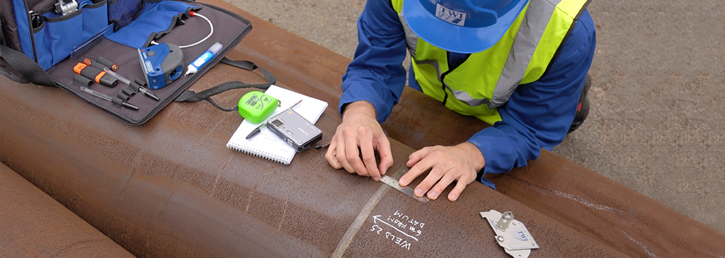Comprehending the Fundamentals of Welding Evaluation to Guarantee High Quality and Security
In the realm of contemporary engineering, welding inspection stands as a cornerstone for ensuring both the top quality and safety and security of architectural developments. The process involves a meticulous evaluation of bonded joints, utilizing advanced methods such as ultrasonic and radiographic screening to identify concealed flaws. The competence of licensed inspectors is vital, as they connect the gap in between academic standards and practical application. Their duty prolongs beyond plain discovery, including the documentation and interaction of findings to relevant stakeholders. Yet, what are the subtleties of these evaluation methods that make them essential for maintaining architectural integrity?

Value of Welding Evaluation
In the world of industrial construction, the significance of welding evaluation can not be overemphasized. Welding examination plays an important duty in guaranteeing the honesty, safety, and durability of welded structures (Welding Inspection Madison).
The process of welding naturally entails intricate variables, consisting of temperature, product properties, and environmental conditions, every one of which can affect the high quality of the weld. An extensive evaluation identifies issues such as splits, porosity, and incomplete blend, which can jeopardize the strength and integrity of the weld. By identifying these problems early, corrective activities can be taken, thus reducing the threat of failure and connected costs.
In addition, welding evaluation adds to regulative compliance, as several industries are controlled by stringent security standards and guidelines. Failing to abide by these regulations can lead to monetary charges and lawful obligations. Inevitably, welding evaluation not just safeguards physical structures however additionally shields human lives and maintains sector credibilities.

Trick Welding Evaluation Techniques
Although welding evaluation is important to making sure the high quality and security of welded structures, it is the details approaches utilized that establish the performance of the examination process. Key welding inspection approaches can be extensively categorized right into non-destructive screening (NDT) and destructive screening.
Magnetic fragment screening and liquid penetrant screening are surface inspection approaches utilized to situate surface and near-surface problems. These comprehensive assessment approaches make certain that welds meet sector standards and security needs, therefore guaranteeing architectural honesty and efficiency.
Duty of Certified Inspectors
Licensed examiners play a crucial duty in the welding inspection process, guaranteeing that all welds adhere to stringent industry criteria and safety laws. Their expertise is important in identifying problems or abnormalities that may compromise the structural honesty of a weld. By meticulously examining each weld, certified assessors assist avoid potential failings that could bring about expensive repair services or unsafe mishaps.
To end up being certified, assessors have to undertake rigorous training and screening, which familiarizes them with numerous welding methods, products, and testing methods. This comprehensive expertise permits them to examine weld top quality effectively and make educated judgments regarding their safety and integrity. Certified assessors are skilled in analyzing requirements and blueprints, ensuring that the welding work aligns with the job's design demands.
An important component of their duty is to record their findings completely, supplying a detailed record of the evaluation process. Their payment is crucial in maintaining high levels of high quality and safety in welding operations.

Devices Used in Welding Examination
Welding assessors count on a selection of specialized devices to navigate to this website execute their tasks effectively, ensuring each weld fulfills the needed requirements. Amongst these tools, aesthetic inspection aids like multiplying glasses and mirrors are basic, permitting examiners to very closely analyze welds for surface issues such as splits, porosity, and undercut. Calipers and fillet weld gauges are important for measuring weld measurements to confirm compliance with layout specs.
Advanced tools expand beyond aesthetic aids, including non-destructive screening (NDT) devices. Ultrasonic screening gadgets are critical in detecting subsurface imperfections, using acoustic waves to disclose inner gaps without compromising the weld's honesty. Likewise, radiographic testing employs X-rays or gamma rays to record pictures of a weld's inside, highlighting prospective issues.
Magnetic fragment testing is an additional get more crucial device, particularly for identifying surface area and near-surface gaps in ferromagnetic products. By applying magnetic areas and ferrous particles, inspectors can determine imperfections that might or else be unseen.
Dye penetrant examination is typically made use of for non-ferrous materials, supplying a contrast-enhanced aesthetic look for surface-breaking problems. Welding Inspection Madison. With each other, these devices enable welding examiners to thoroughly evaluate weld top quality, ensuring safety and dependability in numerous applications throughout industries
Guaranteeing Structural Stability

Welding treatments have to abide by recognized criteria and codes, such as those defined by the American Welding Society (AWS) or the International Company for Standardization (ISO) These guidelines ensure that the welds can withstand ecological variables and functional stress and anxieties. Certified and accredited welders play an essential duty in this process, as their knowledge ensures that methods are applied properly, minimizing issues such as fractures, Related Site porosity, and incomplete blend.
Post-weld inspection is an additional necessary element of validating architectural integrity. These inspections validate that the welds meet the called for top quality requirements, giving guarantee of their sturdiness and dependability.
Conclusion
The fundamentals of welding examination are necessary for maintaining the top quality and security of welded frameworks. The use of specialized devices even more boosts the assessment process, eventually safeguarding human lives and lengthening the life expectancy of bonded buildings.
Welding evaluation plays a crucial duty in guaranteeing the honesty, security, and long life of welded frameworks.Although welding inspection is important to guaranteeing the top quality and safety of welded frameworks, it is the specific methods utilized that determine the efficiency of the examination process. Secret welding examination methods can be extensively classified into non-destructive testing (NDT) and harmful screening.Certified examiners play an essential duty in the welding evaluation procedure, making certain that all welds comply with rigid sector criteria and safety guidelines.The principles of welding examination are important for preserving the high quality and safety of bonded frameworks.